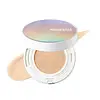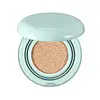What's inside
What's inside
 Key Ingredients
Key Ingredients

 Benefits
Benefits

 Concerns
Concerns

 Ingredients Side-by-side
Ingredients Side-by-side

Water
Skin ConditioningCI 77891
Cosmetic ColorantCyclopentasiloxane
EmollientEthylhexyl Methoxycinnamate
UV AbsorberMethyl Trimethicone
Skin ConditioningEthylhexyl Salicylate
UV AbsorberIsononyl Isononanoate
EmollientAlcohol Denat.
AntimicrobialButylene Glycol
HumectantPEG-10 Dimethicone
Skin ConditioningNiacinamide
SmoothingPentylene Glycol
Skin ConditioningSilica
AbrasiveSynthetic Fluorphlogopite
Bis-PEG/PPG-14/14 Dimethicone
EmollientHydrolyzed Vegetable Protein
Skin ConditioningTrimethylsiloxysilicate
EmollientDisteardimonium Hectorite
StabilisingMagnesium Sulfate
Isododecane
EmollientStearic Acid
CleansingAlumina
AbrasiveAcrylates/Polytrimethylsiloxymethacrylate Copolymer
Skin ConditioningTriethoxycaprylylsilane
Aluminum Hydroxide
EmollientEthylhexylglycerin
Skin ConditioningAdenosine
Skin ConditioningMaltodextrin
AbsorbentDisodium EDTA
Phenoxyethanol
PreservativeParfum
MaskingCI 77492
Cosmetic ColorantCI 77491
Cosmetic ColorantCI 77499
Cosmetic ColorantWater, CI 77891, Cyclopentasiloxane, Ethylhexyl Methoxycinnamate, Methyl Trimethicone, Ethylhexyl Salicylate, Isononyl Isononanoate, Alcohol Denat., Butylene Glycol, PEG-10 Dimethicone, Niacinamide, Pentylene Glycol, Silica, Synthetic Fluorphlogopite, Bis-PEG/PPG-14/14 Dimethicone, Hydrolyzed Vegetable Protein, Trimethylsiloxysilicate, Disteardimonium Hectorite, Magnesium Sulfate, Isododecane, Stearic Acid, Alumina, Acrylates/Polytrimethylsiloxymethacrylate Copolymer, Triethoxycaprylylsilane, Aluminum Hydroxide, Ethylhexylglycerin, Adenosine, Maltodextrin, Disodium EDTA, Phenoxyethanol, Parfum, CI 77492, CI 77491, CI 77499
Water
Skin ConditioningCI 77891
Cosmetic ColorantCyclopentasiloxane
EmollientButylene Glycol
HumectantMethyl Trimethicone
Skin ConditioningPentaerythrityl Tetraethylhexanoate
EmollientPEG-10 Dimethicone
Skin ConditioningCyclohexasiloxane
EmollientSilica
AbrasiveBoron Nitride
AbsorbentMica
Cosmetic ColorantLauryl Polyglyceryl-3 Polydimethylsiloxyethyl Dimethicone
Skin ConditioningDimethicone
EmollientTrimethylsiloxysilicate
EmollientDiisostearyl Malate
EmollientVinyl Dimethicone/Methicone Silsesquioxane Crosspolymer
CI 77492
Cosmetic ColorantPolymethyl Methacrylate
Disteardimonium Hectorite
StabilisingAcrylates/Ethylhexyl Acrylate/Dimethicone Methacrylate Copolymer
Skin ConditioningPolysilicone-11
Sodium Chloride
MaskingPanthenol
Skin ConditioningAlumina
AbrasiveAluminum Hydroxide
EmollientDimethicone/Vinyl Dimethicone Crosspolymer
Skin ConditioningTriethoxycaprylylsilane
CI 77491
Cosmetic ColorantCaprylyl Glycol
EmollientPolysorbate 80
EmulsifyingEthylhexylglycerin
Skin ConditioningGlyceryl Caprylate
EmollientHydrogenated Lecithin
EmulsifyingMethicone
EmollientCI 77499
Cosmetic ColorantDisodium EDTA
Propanediol
SolventPolymethylsilsesquioxane
Aluminum Starch Octenylsuccinate
Absorbent1,2-Hexanediol
Skin ConditioningTocopherol
AntioxidantCamellia Sinensis Leaf Extract
AntimicrobialWater, CI 77891, Cyclopentasiloxane, Butylene Glycol, Methyl Trimethicone, Pentaerythrityl Tetraethylhexanoate, PEG-10 Dimethicone, Cyclohexasiloxane, Silica, Boron Nitride, Mica, Lauryl Polyglyceryl-3 Polydimethylsiloxyethyl Dimethicone, Dimethicone, Trimethylsiloxysilicate, Diisostearyl Malate, Vinyl Dimethicone/Methicone Silsesquioxane Crosspolymer, CI 77492, Polymethyl Methacrylate, Disteardimonium Hectorite, Acrylates/Ethylhexyl Acrylate/Dimethicone Methacrylate Copolymer, Polysilicone-11, Sodium Chloride, Panthenol, Alumina, Aluminum Hydroxide, Dimethicone/Vinyl Dimethicone Crosspolymer, Triethoxycaprylylsilane, CI 77491, Caprylyl Glycol, Polysorbate 80, Ethylhexylglycerin, Glyceryl Caprylate, Hydrogenated Lecithin, Methicone, CI 77499, Disodium EDTA, Propanediol, Polymethylsilsesquioxane, Aluminum Starch Octenylsuccinate, 1,2-Hexanediol, Tocopherol, Camellia Sinensis Leaf Extract
Ingredients Explained
These ingredients are found in both products.
Ingredients higher up in an ingredient list are typically present in a larger amount.
Alumina is another name for the compound aluminum oxide. It is used as a thickener, absorbent, and abrasive.
As an absorbent, alumina can give a mattifying effect. It is used in mineral sunscreens to help coat nano-sized filters, such as titanium dioxide. By increasing the size of the UV filters, these ingredients stay on the skin for a longer time. By coating small sized ingredients, alumina helps thicken a product.
Alumina may be used as an abrasive, or exfoliant.
Alumina is naturally occurring in the mineral corundum. Certain varieties of corundum create rubies and sapphires. Corundum is also the crystalline form of alumina.
Learn more about AluminaAluminum Hydroxide is a form of aluminum. It can be naturally found in nature as the mineral gibbsite. In cosmetics, Aluminum Hydroxide is used as a colorant, pH adjuster, and absorbent.
As a colorant, Aluminum Hydroxide may add opacity, or reduce the transparency. Aluminum hydroxide is contains both basic and acidic properties.
According to manufacturers, this ingredient is an emollient and humectant. This means it helps hydrate the skin.
In medicine, this ingredient is used to help relieve heartburn and help heal ulcers.
There is currently no credible scientific evidence linking aluminum hydroxide in cosmetics to increased cancer risk.
Major health organizations allow the use of aluminum hydroxide in personal care products and have not flagged it as a carcinogenic risk at typical usage levels.
Learn more about Aluminum HydroxideButylene Glycol (or BG) is used within cosmetic products for a few different reasons:
Overall, Butylene Glycol is a safe and well-rounded ingredient that works well with other ingredients.
Though this ingredient works well with most skin types, some people with sensitive skin may experience a reaction such as allergic rashes, closed comedones, or itchiness.
Learn more about Butylene GlycolCi 77491 is also hydrated iron III oxide. It's sole purpose is to give a red/pink hue to products.
Iron III oxides are classified as inorganic chemicals for coloring.
Synthetically created Ci 77491 is considered safer than those naturally found. This is because the synthetically created version may contain less impurities. Iron oxides are generally non-toxic and non-allergenic.
Learn more about CI 77491Ci 77492 is also hydrated iron III oxide. It's sole purpose is to give a yellow hue to products.
Iron III oxides are classified as inorganic chemicals for coloring.
Synthetically created Ci 77492 is considered safer than those naturally found. This is because the synthetically created version may contain less impurities. Iron oxides are generally non-toxic and non-allergenic.
Learn more about CI 77492Ci 77499 is also hydrated iron III oxide. It is created from mixing red and black iron oxides. This helps give shades of darkness to a product.
Iron III oxides are classified as inorganic chemicals for coloring.
Ci 77891 is a white pigment from Titanium dioxide. It is naturally found in minerals such as rutile and ilmenite.
It's main function is to add a white color to cosmetics. It can also be mixed with other colors to create different shades.
Ci 77891 is commonly found in sunscreens due to its ability to block UV rays.
Learn more about CI 77891Cyclopentasiloxane, or D5, is a silicone used to improve texture of products and trap moisture.
D5 is considered lightweight and volatile. Volatile means it evaporates quickly after application. Once evaporated, D5 leaves a thin barrier that helps keep skin hydrated.
It is also an emollient. Emollients help soften the skin and prevent water loss. Silicones create a silky texture in products. D5 helps other ingredients become more spreadable.
Studies show D5 is safe to use in skincare products. We recommend speaking with a skincare professional if you have concerns.
Learn more about CyclopentasiloxaneDisodium EDTA plays a role in making products more stable by aiding other preservatives.
It is a chelating agent, meaning it neutralizes metal ions that may be found in a product.
Disodium EDTA is a salt of edetic acid and is found to be safe in cosmetic ingredients.
Learn more about Disodium EDTADisteardimonium Hectorite comes from the clay mineral named hectorite. It is used to add thickness to a product.
It can also help stabilize a product by helping to disperse other ingredients.
Hectorite is a rare, white clay mineral.
Learn more about Disteardimonium HectoriteEthylhexylglycerin (we can't pronounce this either) is commonly used as a preservative and skin softener. It is derived from glyceryl.
You might see Ethylhexylglycerin often paired with other preservatives such as phenoxyethanol. Ethylhexylglycerin has been found to increase the effectiveness of these other preservatives.
Methyl Trimethicone is a type of silicone. It is a solvent and emulsifier.
Solvents are used to keep ingredients together in a product. They can help dissolve ingredients to stable bases or help evenly distribute ingredients throughout the product.
Emulsifiers help stabilize a product. It does this by preventing certain ingredients from separating.
Methyl Trimethicone does not get absorbed into the skin.
Learn more about Methyl TrimethiconePeg-10 Dimethicone is silicone with conditioner and emulsifier properties. It mostly acts as an emollient in skincare and and humectant in haircare.
According to the manufacturer, acidic formulations decrease the stability of this ingredient. It works best in neutral or near neutral formulations.
Silica, also known as silicon dioxide, is a naturally occurring mineral. It is used as a fine, spherical, and porous powder in cosmetics.
Though it has exfoliant properties, the function of silica varies depending on the product.
The unique structure of silica enhances the spreadability and adds smoothness, making it a great texture enhancer.
It is also used as an active carrier, emulsifier, and mattifier due to its ability to absorb excess oil.
In some products, tiny microneedles called spicules are made from silica or hydrolyzed sponge. When you rub them in, they lightly polish away dead skin layers and enhance the penetration of active ingredients.
Learn more about SilicaTriethoxycaprylylsilane is a silicone used to bind and stabilize ingredients.
As an emulsifier, it helps prevent ingredients from separating. This can help elongate the shelf life of products.
Triethoxycaprylylsilane is often used to coat mineral sunscreens ingredients to help give a better feel. It also helps reduce oxidative stress in sunscreens.
Learn more about TriethoxycaprylylsilaneThis silicone is an emollient. Emollients create a thin film on the skin to prevent moisture from escaping.
It is not soluble in water and helps increase water-resistance in products.
According to a manufacturer, it can blend seamlessly with silicone oils, such as Cyclopentasiloxane.
Learn more about TrimethylsiloxysilicateWater. It's the most common cosmetic ingredient of all. You'll usually see it at the top of ingredient lists, meaning that it makes up the largest part of the product.
So why is it so popular? Water most often acts as a solvent - this means that it helps dissolve other ingredients into the formulation.
You'll also recognize water as that liquid we all need to stay alive. If you see this, drink a glass of water. Stay hydrated!
Learn more about Water